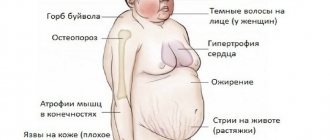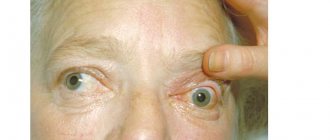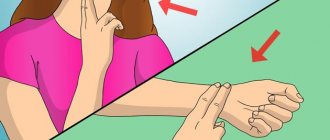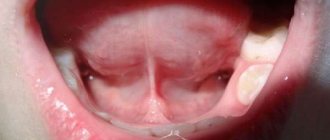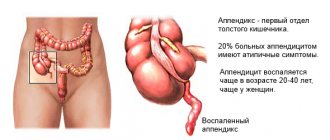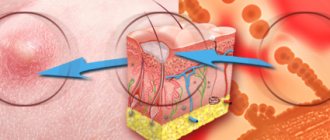Many boys at one stage or another in their lives are faced with an infectious and inflammatory disease of the foreskin and head of the organ, called balanoposthitis. Acute inflammation of the foreskin in boys lasts no more than three months; with a chronic course, the disease lasts more than three months. This pathology is three times more common in boys than in mature men. The disease can cause complications, so it is important to identify symptoms as early as possible and begin adequate treatment.
Concept and characteristics
Balanoposthitis is an inflammatory process that involves the area of the glans penis, as well as part of the foreskin.
The disease is acquired in nature, occurring as a result of infection, trauma to the penis, or as one of the manifestations of an allergic reaction.
In young children, the most common infectious and traumatic forms . The pathology develops gradually when a large amount of pathogenic microflora accumulates between the skin of the foreskin and the head of the penis, the vital activity of which causes inflammation.
Prevention
Prevention of balanoposthitis in children should consist, first of all, of following the rules of hygiene . Washing the genitals and bathing the baby should be regular. However, it is not necessary to always use detergents.
In infancy, boys need to regularly change diapers and diapers, treat problem areas with powder or baby cream to avoid irritation. Older children should buy only natural underwear, without front seams.
▼We RECOMMEND YOU TO STUDY▼
Causes
The main reason for the development of balanoposthitis is considered to be the proliferation of pathogenic microbes in the area between the foreskin and the head.
The causative agents of the disease are bacteria (streptococci, staphylococci and others). Negative factors that provoke the development and reproduction of pathogenic microflora can be different:
- Lack of personal hygiene . It is known that young boys in most cases suffer from physiological phimosis, when the foreskin has a very narrow opening. This leads to the inability to completely expose the head of the penis, and, accordingly, to perform proper hygiene procedures. As a result, urine and secretory fluid accumulate in this area. This is a favorable environment for the growth of bacteria.
- Diabetes mellitus , when the patient’s urine contains a large amount of sugar, which is also a favorite food product for microorganisms.
- Phimosis.
- Incorrectly selected, in particular, too tight underwear , wearing which can lead to the appearance of microcracks in the foreskin area. The development of this situation can also be caused by the incorrect selection of diapers for young children.
- Using the wrong washing powder . It is known that many children develop an allergic reaction to household chemicals (including washing powder), so it is best for parents to give preference to special children's washing powders, which are considered anti-allergenic. The same applies to personal hygiene products used for bathing a child (and washing the penis in particular).
Read about the treatment of myopia in school-age children here.
What does inflammation look like?
It often happens that the excessive care and concern of young mothers about the future sexual function of their son pushes them to completely thoughtless actions and actions, leading to the emergence of many problems.
Inflammation of the foreskin is medically called balanoposthitis. The disease often affects the head and has a very frightening appearance, but at the same time it does not pose a serious threat to the baby’s health unless it becomes chronic.
The most common cause of such inflammation in a child is the parents’ attempt to free the head on their own, believing that it is “time”, thereby violating the natural protection of the organ and allowing various pathogenic organisms free access to the preputial sac.
Sometimes the appearance of the disease also has physiological problems. Under the child’s foreskin, smegma usually accumulates (a mixture of dead skin cells and sebaceous gland secretions), which, with the gradual resorption of synechiae and the release of the head, is washed out on its own during normal urination.
But if the process is disrupted and the synechiae are only partially separated, a skin pouch is formed, from where the smegma cannot come out and forms a dense smegmolite, which becomes the cause of the inflammatory process.
In some cases, the appearance of balanoposthitis is caused by an allergic reaction, when the inflammatory process occurs due to a lack of hygiene procedures, the use of inappropriate diapers or hygiene products, due to untimely change of underwear or washing things with chemical powders.
Often the disease occurs in the presence of food (drug) or respiratory allergies, when the allergen that enters the child’s body is excreted in the urine and causes irritation of the foreskin, followed by an inflammatory process.
The recurrent form of balanoposthitis is often a symptom of existing phimosis, when the foreskin is very narrow and does not allow the head to open independently even in adolescence. In this case, circumcision is required - a simple and non-hazardous surgical operation. Read more about circumcision →
Who is at risk?
As follows from the concept of disease, only males suffer from pathology. Moreover, it is known that in childhood balanoposthitis occurs almost 3 times more often than in adulthood.
This is due to the fact that many boys experience a phenomenon called physiological phimosis (when it is impossible to completely expose the head of the penis from the foreskin).
As a rule, this phenomenon disappears on its own by 11-12 years.
Chronic balanoposthitis
Chronic balanoposthitis develops when the treatment of an acute disease has not been completed. This form lasts for months, subsiding a little during the period of treatment and worsening again after its completion. It often occurs when parents try to open the baby's foreskin by force. Chronic balanoposthitis can occur in the following forms:
- ulcerative-hypertrophic, manifests itself in the form of long-term non-healing ulcers, accompanied by redness and pain;
- adhesive balanoposthitis, the symptoms of which are manifested by bloody wounds and characteristic discharge.
The general symptoms are somewhat different, not so sharp, but not disappearing for a long time:
- itching in the foreskin;
- painful sensations;
- slight hyperemia and swelling of the glans penis;
- whitish discharge.
Chronic balanoposthitis is practically untreatable. After several relapses, surgery to circumcise the foreskin is usually suggested. It is carried out after the inflammatory phenomena have subsided; after its implementation, all manifestations and relapses of the disease usually disappear. In addition, surgical intervention relieves the child from problems such as phimosis and paraphimosis in the future. Circumcision surgery is recommended even for infants.
Forms of the disease
Depending on the course of the disease and the severity of the clinical picture, there are 3 main forms of balanoposthitis:
- The acute form is characterized by a sudden onset and rapid development of symptoms. The boy may experience symptoms such as redness of the foreskin and swelling in this area. The baby experiences discomfort in the penis area and complains of pain and burning. These symptoms worsen with urination. The child’s health deteriorates and hyperthermia may occur. Over time, this form develops into a purulent one.
- The purulent form is characterized by the development of a more severe inflammatory process, accompanied by suppuration in the affected area. A distinctive feature of this form is the appearance of purulent discharge from under the skin of the foreskin.
- In the absence of necessary treatment, the acute form can become chronic . The clinical picture in this case is mild; slight redness and swelling of the foreskin may occur. The child also has a whitish discharge from under the foreskin, which has a distinct specific odor.
What are the symptoms of Hirschsprung's disease in newborns? Find out the answer right now.
Symptoms of balanoposthitis
Acute inflammation appears suddenly. Difficulties in diagnosis can arise only when a very young child is ill, who cannot yet not only say, but also indicate the location of inflammation. Here, the attentiveness of parents plays an important role, who in most cases can see signs of trouble already in the initial stages of the disease.
Symptoms are typical for skin inflammation, but they also have some specific manifestations:
- Redness in the affected area;
- Pain and hyperthermia at the site of inflammation;
- Painful urination, as a result of which the child tries to perform this action as little as possible, which in itself can provoke suffering;
- In advanced cases, the release of pus, drying of its drops on the skin, causing additional irritation;
- Maceration (violation of the integrity of the upper layers) of the epidermis;
- Skin cracks, microscars;
- Synechia - gluing of individual areas, leading to deformation of the organ and complications of functioning;
- Increase in temperature (not always);
- Poor sleep;
- Decreased appetite and activity of the child.
Even a few of these manifestations characterize trouble and make the child suffer.
Symptoms and signs
Balanoposthitis is a disease characterized by a specific clinical picture .
Balanoposthitis in a child - photo:
The presence of pathology is indicated by such signs as:
- painful sensations in the area of the head of the penis. Pain and discomfort become more obvious when urinating;
- the presence of purulent or white discharge with a cheesy consistency. Discharge can be noticed when the foreskin is pulled back. As a rule, they have a strong unpleasant odor;
- redness, swelling of the scalp;
- rashes, and microcracks may appear on the skin of the head of the penis ;
- the skin in the affected area begins to peel ;
- the child becomes more irritable, sleeps worse, refuses to eat, cries for no apparent reason;
- in some cases, a slight increase in body temperature may be observed;
- lymph nodes enlarge in the groin area ;
- Balanoposthitis often provokes the development of enuresis , since the boy, fearing pain when urinating, strives to hold urine for as long as possible. Delayed emptying of the bladder leads to the development of enuresis.
Prevention of balanoposthitis in children
Preventive measures include compliance with basic hygiene standards:
- It is necessary to change diapers more often and ensure that they are the appropriate size.
- It is mandatory to wash the child after defecation.
- To care for your baby's skin, use hypoallergenic creams and powders.
- It is recommended to select underwear for a boy made from natural material, without rough seams at the front. Underwear should not be too tight or restrict movement.
- When performing daily hygiene procedures, you should not constantly use soap. It is enough to wash the genitals with warm water.
- For existing endocrine diseases and urological pathologies, it is necessary to carry out therapeutic therapy and observe precautions.
- Overheating should be avoided; warm clothing or constant wearing of diapers during the hot season increases moisture in the groin area, which promotes the proliferation of pathogenic microbes.
Diagnostics and tests
In most cases, to make an accurate diagnosis, it is enough for the doctor to interview and examine the patient , since the pathology has a very specific clinical picture.
However, if the disease has developed into a purulent or chronic form, a number of additional laboratory tests may be required:
- A general blood test allows you to assess how intense the inflammatory process is.
- General urine test , which allows you to establish or exclude the penetration of infection into the area of the urinary canal.
- Blood sugar test to rule out diabetes.
- A tank culture from the inflamed area of the penis allows you to determine the causative agent of the disease.
Recommendations for the treatment of Kawasaki disease in children can be found on our website.
Possible complications
If the treatment of balanoposthitis was inadequate or not carried out at all, the disease will give the following complications:
- transition to a chronic form;
- due to swelling, acute urinary retention occurs;
- the infection easily spreads throughout the body, causing other pathologies;
- phimosis develops;
- the head of the penis is deformed;
- in severe cases, gangrene of the penis develops;
- the most dangerous complication is a tumor of the head of the organ.
Even if you contact your pediatrician with this problem, he will refer you to a urologist or surgeon. If the cause of the pathology is internal diseases, then additional consultation with a nutritionist, endocrinologist, allergist or immunologist will be required.
Drug treatment
The most common drugs for treating balanoposthitis at home are topical agents, ointments, gels (for example, Levomekol, Miramistin, Baneocin ). They must be used as prescribed by a doctor.
Before the procedure, it is necessary to thoroughly clean the child’s genitals.
The ointment is applied under the skin of the foreskin, and if this is not possible, it is used in the form of compresses or bandages (apply a small amount of ointment to a sterile bandage, make a bandage). The course of treatment is about 3-6 days , the procedure is carried out 2-3 times a day.
In some cases, for example, if the causative agent of the disease is fungi, or the pathology has a complicated course, the doctor prescribes antibiotics ( Cefazolin, Cefixime ).
The course of treatment is determined for each patient individually, however, as a rule, the dosage and duration of antibiotic use for balanoposthitis is small, thus the risk of developing negative consequences is minimized .
Treatment of balanoposthitis and its prevention
At the first symptoms of pathology, you should contact a pediatric urologist or surgeon. The doctor will prescribe tests and examinations. As a rule, a laboratory examination of discharge from the foreskin area is performed. During the analysis, the causative agent of the disease is identified and its sensitivity to antibacterial agents is assessed. This will allow you to choose the right treatment. So, if the disease is caused by fungal microorganisms, then taking antibiotics is contraindicated.
Mild forms of balanoposthitis are treated on an outpatient basis.
If the child's foreskin is red, the following local procedures are indicated:
Appointment with a urologist: preparation for examination, diagnosis and treatment measures
- The doctor will prescribe warm baths with the addition of furatsilin solution (take 2 tablets per 250 ml of water). Baths with chamomile decoction will also help (take 15 grams of flowers per glass). The prepared solution is poured into a jar and the inflamed organ is lowered into it. Such baths are repeated every two hours.
Attention! During the procedures, there is no need to retract the foreskin so as not to provoke pain in the boy.
- After the bath, a gauze bandage with Levomekol ointment is applied to the organ. This warm ointment is also allowed to be gently inserted under the foreskin. To do this, take the product into a syringe without a needle (approximately 1.5 g) and insert its tip under the edge of the skin. In the same way, wash the tissue under the foreskin with a solution of Chlorhexidine or Furacilin. The gauze bandage with ointment is left overnight.
- If you get wet, a specialist will prescribe baths with potassium permanganate. The pale pink solution has a drying and disinfecting effect. The effect of this treatment is noticeable on the third or fourth day.
For severe inflammation of the foreskin in boys, treatment is carried out using anti-inflammatory medications for internal use. If a severe course of the disease is observed, the general condition of the patient suffers greatly, the child is weakened, or there is a threat of infection spreading throughout the body, systemic antibacterial agents are prescribed.
Worth knowing! When treating candidiasis balanoposthitis, antifungal drugs are prescribed, for example, Clotrimazole ointment.
Conservative treatment of the inflammatory process in the chronic form of the pathology will not give the desired result. In this case, only surgery is indicated - circumcision of the foreskin. In young children, this procedure is performed under general anesthesia; in older children, circumcision is performed under local anesthesia. In case of surgical treatment, 100% recovery is observed.
In order to prevent this disease, it is important to adhere to the following recommendations:
- Preschool children should perform genital hygiene procedures after bowel movements and before going to bed.
- For infants, change diapers promptly and select the correct size.
- When washing, schoolchildren can push back the foreskin themselves and wash the head of the organ with warm water.
- All children should have their own personal towel for intimate hygiene.
- Wearing tight underwear that can injure the delicate tissues of the organ is contraindicated.
Folk recipes
Special baths for bathing a child have a good therapeutic effect.
In order to prepare such a bath, potassium permanganate, which has a pronounced antiseptic effect (it is important to remember that the amount of the ingredient should not be large, since potassium permanganate has a drying effect), or herbal decoctions.
It is good to use decoctions of chamomile and sage. These herbs have an anti-inflammatory, calming effect and accelerate the skin regeneration process.
You can use folk remedies only in combination with the treatment prescribed by your doctor.
Complications of the disease
In most cases, serious consequences do not occur - balanoposthitis manifests itself so clearly that it is almost impossible not to notice and not to react. Only in very weakened children, for example, after radiation therapy or suffering from a persistent decrease in immunity, an atypical, erased course is possible.
Among the complications of advanced purulent balanoposthitis are:
- Irreversible narrowing of the foreskin ring - surgical intervention is required (dissection of the narrowed area with restoration of free extension) - relevant for children over 5 years old;
- Tightening of the skin and loss of elasticity leads to curvature of the position of the organ - treated by a surgeon or urologist;
- Chronicity of the process, sometimes leading to malignant degeneration of a seemingly harmless inflammation.
All these complications can lead to difficulties in the future - adult intimate problems often begin in childhood.
How can I find out more?
Diagnosis of acute balanoposthitis in a boy does not involve specialized measures. There is no need to use any professional equipment. It is enough to examine the patient and analyze the complaints. The doctor examines the child's condition. In some cases, samples are taken for laboratory testing. This allows us to formulate a more accurate picture of the flow.
Purulent balanoposthitis
This form of the disease is a consequence of inflammation, damage to the foreskin and glans. The peculiarity of purulent balanitis is a disease of the inner leaf or a complication of phimosis.
Symptoms of acute purulent balanitis:
- burning, itching;
- swelling, redness.
When trying to pee, the baby experiences severe pain. Purulent discharge occurs that has an unpleasant odor. The causes of the purulent form of the disease are:
- Staphylococci.
- Streptococci.
- Yeast fungi.
Inflammation in a purulent form can also cause various reactions to allergies and narrowness of the foreskin in children.
The main treatment for purulent balanitis is surgery. There are particularly severe cases in which skin grafting is used to expand the penis ring.
The disease balanoposthitis, if not treated in a timely manner, can cause non-infectious forms: psoriasis, diabetes mellitus and infectious complications in the form of:
- syphilis;
- gonorrhea;
- candidiasis;
- herpes;
- trichomoniasis.
Dear parents, monitor the health of your children and know that balanoposthitis will not threaten your children if hygiene rules are strictly observed.
Purulent balanoposthitis is an inflammation of the head with damage to the foreskin, which results in stagnation of discharge and urine with the formation of a purulent process.
The main sign of purulent balanoposthitis is redness, swelling of the head, as well as burning and sometimes itching. Pain occurs when urinating, pus with a specific odor begins to flow.
The cause of purulent balanoposthitis is yeast fungi, staphylococci, and streptococcal microorganisms. Lack of personal hygiene and narrow foreskin lead to purulent inflammation.
In case of severe inflammation with the formation of pus, the surgeon trims the foreskin. In advanced cases, plastic surgery is performed to enlarge the ring of the foreskin.
Levomekol for balanoposthitis
For the treatment of balanoposthitis, Levomekol ointment is most often used. With the help of this ointment, inflammation goes away quite quickly, since the product has an antiseptic and anti-inflammatory effect.
Before using Levomekol, you should thoroughly wash the affected area to remove plaque and pus. For cleansing, you can use a solution of potassium permanganate. Then the area of inflammation needs to be dried and ointment applied. The procedure is carried out 2-3 times daily.
Symptoms: nuances
Signs of acute balanoposthitis in a boy include a deterioration in the patient’s general condition. The child feels unwell and eats and sleeps much worse. Typically, sick children are irritable and capricious. In some cases, examination shows an increase in the volume of lymph nodes in the perineal area. The patient unconsciously tries to delay emptying the bladder due to the pain of this process. This leads to uncontrolled urination. This is possible both at night and during the day.
Deterioration of the patient's condition is observed within four, sometimes five days. The preputial cavity can open on its own, freeing itself from accumulations of smegma. In this case, a complete cure on your own is possible. There are cases where the lack of qualified medical care provoked a change in the form of the disease into a chronic form. This leads to scarring on the foreskin. There is a risk of paraphimosis, phimosis in a pathological form. In some, chronic balanoposthitis is accompanied by urethritis (also in chronic form). Possible deformation of the head of the genital organ.
Methods for treating inflammation of the foreskin in a child
Due to excessive curiosity and comparison with other peers of their child, mothers may begin to independently remove the skin from the head of their son’s penis.
Often this happens under the emotional control of friends or relatives, who rush things and give incorrect recommendations, frightening them about the upcoming surgical intervention. A young mother, afraid of causing pain to her child associated with a far-fetched operation, takes the wrong measures and decisions. She begins to independently move the skin from the head ahead of time. Rushing into such a sensitive topic has serious consequences for children's health.
Acute balanoposthitis is characterized by inflammation of the foreskin of the penis in boys. In the initial stage, the disease is not dangerous. Difficulties arise when treatment of the disease is delayed and balanoposthitis becomes chronic.
The disease is highly treatable. When you contact a qualified specialist and follow his recommendations, symptom relief occurs within the first day, and complete recovery occurs after a few days (usually up to a week).
The doctor prescribes antibacterial ointments or creams aimed at suppressing the inflammatory process. Sometimes local anesthetic forms of medication may also be required. Systemic therapy for balnoposthitis is rare.
To enhance the therapeutic effect for balanoposthitis, the child is bathed in baths. Alternately, chamomile decoction and furatsilin solution are added to water boiled and cooled to a temperature of 38°C. These components have an anti-inflammatory effect.
To prepare a bath with chamomile to treat inflammation of the foreskin in a child, the flowers must be brewed with boiling water in a teapot. Let it sit for one hour in a dark place and pour into cooled boiled water.
The child is bathed in a bath without adding detergents for ten minutes. After this, rinse the skin with water and dry with a soft towel. Bathing continues daily or every other day in alternating sequence with other methods.
Five tablespoons of furatsilin are added to a bath of cooled boiled water. The child is bathed for fifteen minutes, without using detergents. After this, rinse the skin with warm water and dry the baby with a towel.
Baths are used as red skin appears in the groin area in children until complete recovery. When bathing, there is no need to open the head; a sufficient amount of medicine will wash the skin inside the foreskin and rid it of viruses and bacteria.
The use of potassium permanganate (potassium permanganate) to wash children is only possible if the skin is not too dry. The product has a drying effect. In some cases, it may be harmful to health.
Preventive measures regarding balanoposthitis include ensuring proper care for the baby:
- You cannot retract the foreskin on your own and expose the head of the penis.
- You should not wash and treat the area under the foreskin with disinfectants every day.
- After each urination and defecation, the child’s skin must be washed under running water without using cosmetics.
- Use diapers that do not irritate the baby's skin.
- Twice a week, bathe the boy in a chamomile decoction in combination with other herbal decoctions.
- Carry out a daily inspection with clean hands; at the slightest suspicion of inflammation of the foreskin, consult a doctor.
- Start treatment from the first day of the onset of the disease to prevent complications in the form of a chronic form of the disease.
Balanoposthitis is not the most serious disease in boys. With timely treatment and proper care for the baby, it will pass quickly. Try to prevent the formation of a chronic form. Take your child seriously, creating optimal conditions for his healthy life.
What to do?
If symptoms of acute balanoposthitis in a boy indicate the need for treatment, it is necessary to show the child to a doctor. Only a specialist can choose an adequate course of combating the disease. In the majority of cases, local therapy is chosen. Sitz baths are prescribed. For the procedure, herbal infusions, extracts, and decoctions are used. You can make baths with antiseptic drugs. Instillation of an antiseptic under the foreskin is allowed. If it is not possible to expose the head of the penis, they may be advised to agree to surgery. Such an event helps to separate the synechiae and free the preputial sac from pathological accumulations.
What do parents say?
As can be concluded from the reviews, acute balanoposthitis in boys brings a lot of suffering to the patient. No less is the anxiety that parents whose baby is a victim of the disease are forced to face. Some note that balanoposthitis bothered them, despite a very responsible attitude to hygiene. This proves that harsh chemicals used for washing irritate children's delicate skin. But people who teach children from a young age to take care of themselves, and until they acquire such skills, are responsible for the hygiene of the baby, without using an excessive amount of aggressive means, rarely complain about this problem.
Many note that the treatment of balanoposthitis did not cause any particular difficulties. Some people say in their reviews that the child’s illness went away on its own, although there was no therapy. Despite the fairly large number of such cases, it is not worth taking risks and saving, so as not to provoke undesirable consequences and complications.
Features of the development of infant boys
When a child is born, every mother torments herself with many questions about how to properly care for her newborn so as not to harm her. It is especially difficult when a son is born. How to properly care for the male organ is taught in maternity schools. Consultation on the care of the head and foreskin should be carried out by doctors in the maternity ward. When raising a boy, this problem plays an important role.
At birth, a baby's penis already has a fold of skin covering its head. It has a scientific name - preputium. At the same time, congenital phimosis is observed in all babies at birth. This is a condition that does not allow the head of the foreskin to be exposed. Doctors should warn new mothers not to touch the tip of the penis with unwashed hands. This can lead to inflammation of the baby's head and foreskin.
The inner surface of the prepuce and the head of the genital organ are connected with the help of synechiae of the foreskin. In a newborn, they are very tender and do not have elasticity, which does not allow them to be pulled off the head of the penis, as in adult men. The physiological role of these synechiae at an early age is to reduce the risk of infection, i.e. they prevent germs from entering the penis.
During the growth and development of a boy, with proper care in infancy, the diameter of the hole covering the head increases. This fact leads to her gradual release. The penis takes on the same appearance as that of an adult man.
The head is finally released due to the onset of erection, as well as under the action of secreted enzymes from the sebaceous glands of the skin. This time period is individual for each boy. According to statistics, on average it occurs at the age of seven years. There are cases when the complete opening of the head from the foreskin occurs early - at the age of 4 years or, conversely, late - by 11 years.
Is it possible to warn?
As the reference books with photos that demonstrate the peculiarities of the course of the disease make it possible to understand, acute balanoposthitis in boys is an extremely unpleasant disease. To prevent it, you need to thoroughly observe hygiene measures. The task of parents is to teach their child to independently maintain reproductive hygiene as early as possible. Babies need especially responsible care from their parents. You need to choose the right diapers and monitor the frequency of replacing these items. No less significant are the measures for washing the genitals and the entire perineal area. It is necessary to care for the child’s skin using specialized products. The task of parents is to choose only safe, non-allergenic compounds.
Diagnostics
Does not pose any great difficulties for a doctor of any specialty. To clarify the diagnosis and select adequate treatment tactics, the patient will be sent for consultation to a urologist, and in his absence, to a surgeon. In some cases, consultation with a dermatovenerologist and other specialized specialists is required to exclude general pathology.
To choose a method of treating balanoposthitis in a child, it is necessary to determine the causative agent , for which culture is carried out on nutrient media and serological tests. The nature of inflammation is clarified by cytological examination of discharge and analysis of the first portion of urine.
First aid for a baby
- If you suspect inflammation of the foreskin and glans, you should seek advice from your local pediatrician, who, if necessary, will refer the child to a urologist. If possible, it is better to visit the doctor on the same day. Just before the examination, you should not perform toileting of the genitals.
- What if this is not possible? In this case, it is possible to begin treatment at home before the examination. However, there is no need to delay your appointment and consultation.
- You cannot try to cure a child on your own or resort to traditional methods of treatment. Delay or improper treatment can lead to the progression of inflammation and the development of complications .
Providing first aid at home to a child with acute balanoposthitis includes:
- 1Preparing lukewarm baths (37 degrees) with chamomile infusion and a slightly pink solution of potassium permanganate. To properly prepare a solution of potassium permanganate, you need to dissolve the grains in a ladle, and only then add the resulting solution to a bath of clean water. Newborns and infants can use boiled water.
- 2Rinse the pocket between the head of the penis and the foreskin using a syringe without a needle (5-10 ml) with a light warm solution of furacillin, sterile warm saline. After washing, smegma (white lumps in large quantities) may be released from the hole in the foreskin. After the procedure, the child usually wants to urinate.
- 3After completing the procedures, apply antibacterial ointment to the foreskin and glans penis (for example, Baneocin ointment, Tetracycline ophthalmic ointment, Triderm, Akriderm GK and Genta).
- 4 We remind you once again that these manipulations can only be performed under the condition that the doctor cannot be available earlier than in 2 days.
- 5Usually these manipulations are enough to prevent complications in time.
How to treat balanoposthitis in men: list of drugs
Treatment of balanoposthitis is inextricably linked with the use of medications.
Creams and ointments, as well as various gels and powders are means for local treatment. If the cause of the disease is an infection, then medications containing an antibiotic should be used. Fungal infection requires the use of antimycotics. At the discretion of the treating doctor, medications with combined effects may be prescribed. If the disease was caused by bacteria, then it will not be possible to do without antibacterial drugs.
A special place is given to local drugs:
- "Miramistin" is the best ointment for treatment, which has a bactericidal effect. Due to its wide spectrum of action, it is prescribed for the treatment of any type of balanoposthitis. The ointment has one side effect - a burning sensation, which goes away on its own after a few minutes. The medicine is not prescribed to people with individual intolerance to its individual components.
- "Levomekol" - helps speed up the healing process. The ointment has proven its effectiveness against many bacteria (aerobes and anaerobes). In case of individual intolerance to its components, an allergic reaction is possible.
- Chlorhexidine is an antiseptic that can be used for rinsing, lotions, baths or compresses. It is allowed to be introduced into the urethra. Adverse reactions are extremely rare and manifest themselves in the form of itching, rash or dry skin. Chlorhexidine does not cause an overdose.
- Hydrogen peroxide is used for disinfection. To do this, it is used to treat the affected areas of the skin. Among the disadvantages of the product is a temporary effect that completely disappears a few hours after use. It is recommended to use peroxide when the first signs of balanoposthitis occur. It is not used if the patient has phimosis.
- Clotrimazole is known for its antimicrobial effect. The medicine is prescribed for candidal balanoposthitis. To do this, the ointment is applied to the skin after hygiene procedures. The duration of use depends on the severity of the disease. In some cases, adverse reactions (redness and burning of the skin) were observed. In this case, the drug should be discontinued and reused only after the side symptoms disappear. "Clotrimazole" is not prescribed to children and people with hypersensitivity to its components.
- Potassium permanganate has excellent antiseptic properties and accelerates the healing process of wounds. It can be used at different stages of pathology. But this must be done carefully, since undissolved grains of potassium permanganate can cause a severe burn. It has no contraindications for use.
- "Triderm" is able to treat balanoposthitis not only at the initial stage, but also when the disease has become chronic. The active components of the ointment are able to relieve inflammation, have antiallergic, antifungal, and antibacterial effects. The drug should be used several times a day for 2-4 weeks. In case of intolerance to the components of the drug, irritation, itching, dry skin, and the appearance of a rash are possible. Triderm should not be used for skin tuberculosis, chickenpox, or skin reactions that occur as a result of vaccination.
- "Furacilin" is used to prepare baths or lotions. The medicine has a broad antimicrobial effect. Skin reactions in the form of rashes and dermatitis are possible. With prolonged use, nerve inflammation may occur. People with kidney disease should be careful.
- Fluconazole is effective only in the case of candidiasis balanoposthitis. It is quickly absorbed into the skin and acts for a long period of time. Analogues of the drug are ointments "Flucostat" and "Diflucan".
- "Bepanten" is used to speed up the healing process of wounds. The ointment has an anti-inflammatory, moisturizing and regenerating effect. The cream is prescribed for the prevention and treatment of balanoposthitis. It is applied to clean and dry skin several times a day. The duration of use depends on the degree of damage and the individual characteristics of the patient. In some cases, a skin reaction may occur, so it is better not to use it for people with high sensitivity to the active components of the drug.
- "Pimafukort" has powerful anti-inflammatory, antifungal and antibacterial effects and is effective against many pathogens. With prolonged use, stretch marks may appear at the site of application. The medicine is not prescribed to children under 1 year of age and to those who are allergic to certain components of the ointment.
- "Fukortsin" is prescribed as an antimicrobial and antifungal agent. It is used to prepare baths, compresses and applications. After it dries on the skin, the treated area must be lubricated with cream. A possible side effect is burning. "Fukortsin" is not used in case of high sensitivity of the patient's body to its components. It is not recommended to treat large areas of skin with it, since the active components can penetrate the bloodstream and have a toxic effect.
- Tetracycline ointment has an antibacterial effect and can stop the proliferation of pathogenic microflora.
Balanoposthitis, as an inflammation of the foreskin, cannot develop in a woman for purely physiological reasons. However, if the disease is caused by an infection, then it is quite possible to transmit it to a sexual partner.
So, there is a risk of infection with the following forms of balanoposthitis:
- Viral, fungal or bacterial form of inflammation. If pathogenic microorganisms enter a healthy mucous membrane, they can begin to multiply on it and provoke the development of the disease. Moreover, intimate intimacy is often accompanied by the appearance of microcracks, which increases the risk of infection.
- Balanoposthitis caused by sexually transmitted diseases. During sexual intercourse, transmission of the herpes virus, bacteria that cause syphilis, mycoplasmosis, etc. is possible. Moreover, the presence of damage to the mucous membrane in this case is not a prerequisite for infection.
- Acute course of the disease. Any disease is more contagious when it is in the acute stage.
As practice shows, transmission of infection during exacerbation of balanoposthitis is extremely rare. After all, the disease causes a man a lot of inconvenience and is accompanied by painful sensations. Therefore, most patients do not think about intimacy at this time.
Etiology
The causative agents of this pathology are pathogenic microorganisms - streptococci, staphylococci, candida.
Factors that can lead to the pathogen entering the baby’s genitals are as follows:
- history of phimosis;
- failure to maintain personal intimate hygiene - due to age, parents themselves need to monitor this;
- wearing tight underwear made of low-quality materials;
- an allergic reaction caused by personal hygiene products and underwear washing products.
Children under five years of age are at risk. However, the development of balanoposthitis in adult men is also not excluded.
Features and provoking phenomena
As reference books containing thematic photos explain, acute balanoposthitis in boys can be explained by a disruption of the normal processes of cleaning the foreskin. These are sometimes caused by synechiae.
Most often, analysis of pathological microflora shows the presence of strepto- and staphylococcus. Infection with E. coli, herpetic virus, and yeast is possible. Sometimes analysis shows Proteus.
Occasionally, the disease is associated with excessive hygienic measures, too frequent washing of the organs of the reproductive system. The risks are great if you use aggressive soap or other active chemicals. Allergies and contact dermatitis occur due to the use of creams. An inflammatory process may develop due to contact of the child’s body with linen contaminated with chemicals (including detergents). In this case, balanoposthitis is usually accompanied by inflammation of the gluteal area and the entire perineum.
Case Features
Candidiasis acute balanoposthitis in boys is relatively rare due to specific anatomical features. The penis is an external organ, so it is less likely to become a breeding ground for bacteria if hygiene rules are followed responsibly. In order for pathogenic microflora from the genus Candida to appear, an optimal degree of humidity must be maintained. Fungi need warmth and a high acidity environment. Thrush is often accompanied by changes in hormonal levels. Usually, when infected with candidiasis, the body successfully copes with the pathology on its own.
In addition to the acute form, candidal balanoposthitis can appear as a chronic disease. An acute disease is easier to cure; it has clear symptoms. Relapses of this course are rare. With candidal balanoposthitis, the head of the penis turns red and swells, bothering the patient with a burning sensation. This part of the body itches and hurts. A whitish covering can be seen on the skin under the foreskin. Emptying the bladder is accompanied by pain, and the lymph nodes in the perineum become enlarged. Examination reveals small ulcers and erosions on the skin of the intimate organs. The patient is irritable and gets tired quickly. Occasionally there is an increase in temperature to subfebrile.
What will happen if left untreated?
Patients whose immune systems are weakened, as well as those who do not observe personal hygiene rules and do not carry out treatment, may develop complications:
- Chronic balanoposthitis can occur if treatment is not started on time or completed prematurely. In this case, remission is possible at first, but later the symptoms of the disease will worsen again. Treating chronic pathology is much more difficult.
- Decreased sexual function. The inflammatory process can lead to receptor atrophy and decreased sensitivity. At the same time, potency decreases.
- Cystitis, prostatitis and other diseases of the genitourinary system. Pathogenic bacteria that cause balanoposthitis can rise up the urethra and cause these diseases. As a rule, this occurs in people with reduced immunity and those who have not followed the principles of treatment.
- Lymphangitis is the transition of the inflammatory process to the inguinal lymph nodes.
- Paraphimosis is compression of the head by the foreskin. In this case, there is a disturbance in the blood circulation of the organ, lymph flow and an increase in the size of the head of the penis, which becomes red and painful. This condition requires immediate medical attention, otherwise gangrene is possible.
- Gangrene of the penis is characterized by the death of tissue that turns black. The disease begins suddenly for a man. As a result, his general condition worsens, the temperature rises and foci of necrosis appear.
Causes of development in babies
There are many reasons for children to develop balanoposthitis. Do not think that balanoposthitis in infants and slightly older children is a fairly rare occurrence. The paragraph above indicates one of the common reasons that is associated with the appearance of phimosis. In addition, the development of balanoposthitis can be caused by a simple lack of proper hygiene of the penis and organs.
If a child of a conscious age is not taught that it is necessary to take a shower every day, as well as other hygienic measures, then it is likely that the baby will acquire balanoposthitis.
There are other reasons that lead to similar diseases. These include obesity, as a result of which harmful substances contained in excess in the body affect the genitourinary system.
Frequent injuries can result either from active games in which the child takes part, or from stiffness as a result of wearing tight underwear made from non-natural fabrics. The presence of endocrine diseases also entails balanoposthitis.
Very often, children try to dress as coolly as possible, while ignoring the advice of adults. Hypothermia can cause a similar problem. As the pediatrician notes, balanoposthitis also manifests itself in cases of severe vitamin deficiency.
Balanitis and balanoposthitis
These two diseases often develop simultaneously. If treatment of acute balanoposthitis in a boy is required, it is likely that balanitis will also need to be treated. This is the name for the inflammatory process affecting the head of the penis. Balanitis is a narrower process than balanoposthitis. In practice, these two pathologies flow into one another. Doctors note: recent studies suggest that the lack of treatment for such a disease can provoke malignant processes in the reproductive system. To avoid such a risk, you need to start therapy in a timely manner, when signs of the inflammatory process are barely noticeable. If the disease is prone to relapse, you should consult a surgeon.
The disease can be primary or secondary. In boys, primary acute balanoposthitis and balanitis appear due to infection with pathological microflora. There is a danger of congenital phimosis, in which the likelihood of these diseases is much higher. Urine and smegma are retained in the preputial sac, and the inflammatory process begins. The secondary form of the disease is observed if the body is already infected with an infection, the focus is outside the penis, but the pathological agent penetrates here, moving through the urethra. Most often, Trichomonas infection occurs in this way. The nature of gonorrheal, syphilitic disease of the head of the penis is similar. If a child is diabetic, suffers from allergies, or eczema, the likelihood of getting sick is much higher.
Candidiasis balanoposthitis
Acute balanoposthitis in boys caused by invasion of fungi from the genus Candida is relatively rare. This disease can be called thrush. Many girls, young women, and women suffer from it, but representatives of the stronger sex suffer from thrush much less often. This is due to the specific anatomy of the male body. Modern doctors know well how to deal with candidiasis balanoposthitis. The task of the parents, the patient and the doctor is to take sufficiently effective measures so that the disease does not become chronic.
Fungi belonging to the genus Candida are classified as opportunistic. This means that they negatively affect human health if certain risk factors are present. In a normal state, the fungus lives in the general volume of microflora in small quantities and does not harm humans in any way. If the immune system weakens, active reproduction of this form begins, as a result, an inflammatory focus develops, and the person becomes ill. The likelihood of such a development is higher if the child suffers from immunodeficiency or diabetic disease, or if the body is infected with a sexually transmitted infection. There is a higher risk that you will have to deal with acute balanoposthitis of the candidal form that has developed in a boy if the child has an autoimmune disease, the skin is affected, or there is a chronic pathology of the reproductive system or any internal organ. The same risks are associated with a lack of vitamins, general exhaustion, and non-compliance with hygiene standards and rules. If a child wears tight underwear made from synthetics, the risk of thrush increases significantly.
